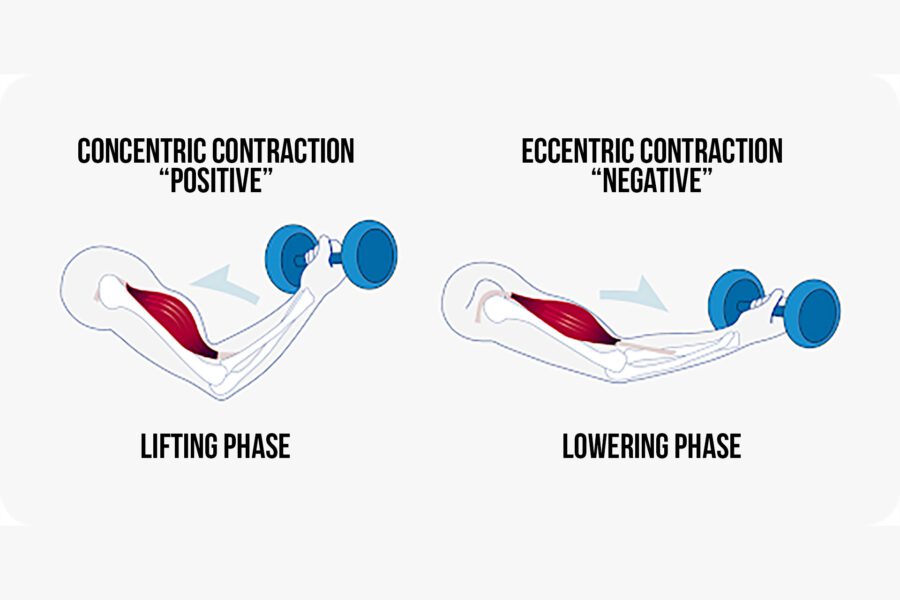Negative Reps: Positive Gains Through Controlled Movements
They say to focus on the positive things in life, and everything will fall into place. However, the gym is one of the few places where paying attention to the 'negative' can exponentially multiply your results.
In strength training, many fitness enthusiasts and athletes aspire to challenge themselves and continue to build a better and stronger physique. To achieve this, a consistent training routine and techniques are required to develop optimal muscle growth.
Among the various strategies that seasoned bodybuilders swear by and have been proven by scientific journals throughout the years is the concept of negative reps. As contradicting as it may sound, negative reps ultimately lead to positive gains if incorporated effectively into one's exercise routine.
This article will dive deep into the science of negative reps and how you can optimize your workouts by utilizing this concept to improve muscle growth and strength gain.
Negative reps focus on what's often the most neglected part of an exercise — the eccentric phase where the muscle is lengthening rather than contracting. Often, people would simply let momentum and gravity do the work to complete this phase of muscle contraction which can actually undermine your progress in the gym.
During each rep, your muscle undergoes 3 phases of muscle contraction.
The concentric phase, or "positive," is the shortening of the muscle during an exercise and is considered the "lifting" part of the movement. Your muscles generate force by contracting and pulling on the bones, which results in movement.
For example, during a bicep curl, the concentric phase occurs as you lift the dumbbell toward your shoulder.
The peak contraction is when the muscle reaches maximum tension during an exercise. It is often brief but significant since it is when the muscle is fully engaged and contracted. Many refer to this phase as the "squeeze" in strength training.
In bicep curl, peak contraction occurs at the top of the movement when the forearm is closest to the shoulder, and the bicep is fully flexed.
The eccentric phase, also known as the "negative" phase, involves the controlled lengthening of the muscle. This phase occurs as the muscle returns to its resting length after contraction.
It's often considered the "lowering" part of a movement and can be more challenging to control. Hence, many lifters neglect this part by letting gravity complete the movement.
For example, during the bicep curl, the eccentric phase happens as you slowly lower the dumbbell back to the starting position.
The eccentric contraction or negative is crucial in building strength and muscles. As you gradually lower the weight and maintain complete control of the movement, the muscle experiences higher tension to overcome the weight or resistance.
During the negative phase, the weight or force applied to the muscle exceeds the momentary force generated by the muscle during the positive phase. Your muscles generate greater forces during a negative rep compared to other types of contractions.
In addition, negative reps recruit less motor unit activation and consume less oxygen than positive reps at the same workload.
The combination of higher force and reduced recruitment of muscle fibers during negative rep causes high mechanical stress on your muscles, resulting in more microtrauma, which ultimately leads to greater stimulus for muscle growth.
Studies have shown that negative reps activate more type 2 muscle fibers which have a 50% greater capacity for muscle growth.
Enhance muscle resilience
The negative phase of muscle contraction leads to more mechanical stress and muscle damage, which is also the prime reason you experience delayed onset muscle soreness (DOMS) when first lifting in the gym or upgrading to more advanced training protocols.
Soon, as you stay consistent with your training routine, your muscles build natural resilience to damage as they become stronger, making each subsequent workout easier and becoming more effective at recovering.
In the field of sports rehabilitation, negative rep training results in greater muscle resilience to injury, particularly in the lower body. Eccentric exercises in athletes have been shown to be effective in preventing sports injuries such as hamstring strain.
In addition, negative reps can also be used for rehabilitation and recovery if you are suffering from an injury. Performing negative reps at a much lesser weight can help regain strength and muscle mass without overstressing the healing tissues at a much lower metabolic requirement.
Being intentional with each rep improves your mind-muscle connection and emphasizes the lift's negative component.
Some studies have shown that emphasizing negative reps during training can result in significantly better muscle growth than standard training styles.
In one study, one group that only performed negative reps gained 5% more muscle fiber area than one that performed only positive reps after 19 weeks of training.
Furthermore, another study found that giving emphasis on the negative part of the lift can lead to at least 10-13% more arm thickness compared to lifters who only did the positives.
Negative reps cause more muscle microtrauma than concentric movements. This controlled damage stimulates a greater response from the body to initiate repair and growth. As the muscle heals, it becomes larger and stronger.
If you've hit a plateau in your training, negative reps can be a powerful tool to overcome it. By pushing the muscles beyond their typical concentric failure, negative reps can challenge the muscles in a new way, leading to renewed progress by improving the intensity of your workout without necessarily increasing the weight lifted or the number of repetitions performed.
Aside from not letting momentum and being mindful not to let gravity get the hold of your reps, you can also use tempo and negative overload to optimize your workouts and utilize the benefits of negative training.
Here’s a plan for men you should try:
And for women:
Tempo or negative control allows you to spend more time on the negative during a lift. You can do this by prolonging the negative part of the lift by intentionally slowing down your tempo as you approach the bottom of the lift.
Generally, a good negative lifting tempo is about 1 to 2 seconds during positive and 2 to 4 seconds on negative. Remember that this technique should be done in a slow and controlled manner.
This technique will lead to muscle fatigue with less load since each rep will take longer to complete.
An example of eccentric control training is performing negative pull-ups wherein you intentionally prolong the lowering part of the exercise. This technique allows lifters to develop upper-body strength even if they are not yet strong enough to complete a standard pull-up.
More importantly, it facilitates motor learning and recruitment of muscle groups involved in regular pull-ups, allowing you to control your body weight more effectively instead of attempting to do consecutive concentric pull-ups with poor movement quality.
Negative overload or eccentric overload training refers to exercises where the force generated by your muscles is significantly less than the weight or resistance they must overcome, resulting in muscle lengthening.
In negative or eccentric overload, the weight or resistance during the negative phase is often greater than what your muscle can handle during the positive phase.
This is possible since the muscles are generally much stronger during the negative and can handle up to 20-40% more weight.
Negative overload typically relies on a spotter or dynamic support from resistant bands to help you safely pull the weight. This is usually seen in compound exercises such as squat overload.
For safety reasons, always use safety bars or power racks to bail on a lift when you have to lift a significant amount of weight.
You can also perform a negative overload using one arm and having the other arm assist the other during the positive, as seen during bicep curl overload.
Using negative reps in your training is one way to maximize your gains in the gym. Performing these techniques will allow you to optimize your lifting techniques and improve your time under tension, resulting in greater muscle strength and gains.
In a nutshell, negative reps allow you to focus on the quality of your movements rather than the volume. Changing the tempo of your lifts by slowing down at the bottom can dramatically influence how much stimulus you put in your muscles.
Frequently Asked Questions
Negative reps focus on the eccentric phase of an exercise, where the muscle lengthens under tension. This phase is often neglected, but controlling it can lead to better muscle growth and strength gains.
Negative reps enhance muscle growth by increasing time under tension during the eccentric phase, which can lead to greater muscle fiber recruitment and hypertrophy. This method challenges muscles in a unique way, promoting strength and size.
Yes, negative reps can be integrated into most strength training routines. They are particularly effective for exercises like bicep curls, bench presses, and squats, where you can safely control the lowering phase of the movement.
While negative reps can be beneficial, beginners should first focus on mastering proper form and technique. Once comfortable, they can gradually incorporate negative reps to enhance their strength training routine.
The concentric phase involves muscle shortening and is typically the 'lifting' part of an exercise, while the eccentric phase involves muscle lengthening, often the 'lowering' part. Both phases are crucial for balanced muscle development.
You can track your progress by noting the weight, number of reps, and the duration of the eccentric phase. Using tools like the Gymaholic App can help you monitor your performance and improvements over time.
For more information on various strength training techniques, you can read related articles such as Strength Training Terminology: Hypertrophy, Volume, etc. and What Are Negative Reps, Strip Sets, Dead Stops and Forced Reps?.


